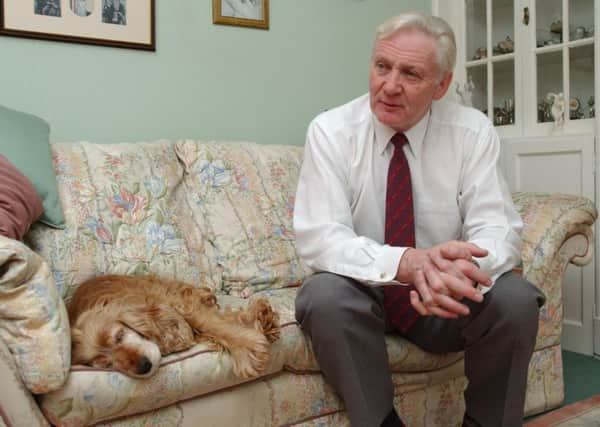Obituary: Stuart Henderson MBE, senior detective whose later career was consumed by the Lockerbie bombing


A stroll across the newly-opened Forth Road Bridge proved a less than ideal romantic date for Stuart Henderson’s girlfriend when the young police officer spotted a suspicious character.
Convinced the tramp-like suspect was the individual from a wanted poster, he persuaded him to accompany them to a local police station. Henderson’s hunch proved correct and the man was detained in connection with the murder of a woman in Fife.
Advertisement
Hide AdAdvertisement
Hide AdIt was an early indication of the young bobby’s instinct and enthusiasm, which, if he could have bottled it, could have made him a fortune, said Tom Wood, his former colleague and former deputy chief constable of Lothian and Borders Police.
Henderson went on to marry the young woman who had sat patiently waiting while his bridge suspect was detained and to forge a career in CID that ultimately saw him take charge of the biggest mass murder inquiry in Scottish criminal history – the bombing of Pan Am flight 103 over Lockerbie in December 1988.
Born in Kingston, London, to Scot Annie Cameron and Henry Henderson, he grew up and was educated in Guildford, Surrey where he became a member of the Sea Cadets. Leaving school at 17, he accompanied his mother when she returned to Edinburgh and decided to stay north of the border, joining the City of Edinburgh Police at 18.
He was a bobby on the beat in the early 1960s when he took his future wife Yvette on that Forth Bridge outing. They married in 1967, around the time he became a detective. Moving up through the ranks, his energy and commitment to the job made him a natural choice to tackle some of the Scottish capital’s more difficult, long-running cases, including the crimes of two serial killers.
He was involved in the investigations into the World’s End case which eventually saw Angus Sinclair convicted for the rape and murder of 17-year-old friends Christine Eadie and Helen Scott who were last seen in the Edinburgh pub in 1977.
He was also on the team investigating the disappearances and murders of two children – five-year-old Caroline Hogg who vanished from Portobello in 1983 and 11-year-old Susan Maxwell who had gone missing the previous year walking home in the Scottish Borders. Robert Black was ultimately convicted of their murders – an incredibly complex inquiry.
“Stuart Henderson was one of the most energetic and committed people you could ever meet,” said Mr Wood. “He was the ultimate enthusiast in everything he did. He was in CID and that was his natural place. He was a first class investigator.
“Any detective can maintain their enthusiasm for a case that lasts for a week, or two weeks, but to retain focus and energy and commitment if it goes on and on and on, suffering setback after setback after setback, you need to be a special kind of person and that was Stuart Henderson.”
Advertisement
Hide AdAdvertisement
Hide AdOn the night of December 21, 1988 he was the most senior Lothian and Borders police officer on duty in Edinburgh and went immediately to the site of the Lockerbie disaster, likening it to a war zone.
For two years he was deputy senior investigating officer for Strathclyde Police’s John Orr on the case which involved the murders of 259 passengers and crew on the plane and 11 residents on the ground. Then, in 1990, when John Orr became deputy chief constable of Dumfries and Galloway, he took complete charge of the hunt for the culprits – a role that completely dominated the latter years of his police career and saw him visit 47 countries.
By now a detective chief superintendent, he worked closely with the FBI agent Richard Marquise, who was in charge of the United States’ task force. Henderson’s work earned him the MBE in the New Years honours of 1992 and he retired that same year after delivering a report to the Procurator Fiscal naming two men allegedly involved in the bombing, Abdelbaset al-Megrahi and Al-amin Khalifa Fhimah.
The latter was acquitted after a trial in the Netherlands but Megrahi was convicted in 2001. In 2009, suffering from cancer, he was released from jail in Scotland on compassionate grounds, a move Henderson vehemently opposed. Both he and Marquise wrote to the then Justice Secretary Kenny MacAskill, urging him not to release the convicted mass murderer.
Henderson, who had marked the 10th and 25th anniversaries of the tragedy at Arlington National Cemetery in Virginia where there is a red sandstone Lockerbie cairn memorial, felt it was a naive move and rejected any suggestion Megrahi had been framed as an insult to the police.
After leaving Lothian and Borders Police, where he had spent the majority of his career at force headquarters, he took a job as chief security officer for the Bank of Scotland where he stayed for five years.
Once fully retired, the enthusiastic sportsman could spend more time swimming and on the golf course as a member of the Royal Burgess Golfing Society.
In his younger years he had played football for Scottish and Edinburgh police teams and was a keen runner, often running across the Forth Bridge and back home while exercising his dog.
Advertisement
Hide AdAdvertisement
Hide AdAs Tom Wood said, quoting from Rudyard Kipling: “ ‘If you can fill the unforgiving minute with sixty seconds’ worth of distance run, yours is the Earth and everything that’s in it,’ – that’s Stuart.”
He is survived by his wife Yvette, daughters Lissette and Vicky, son David and six grandchildren.
ALISON SHAW